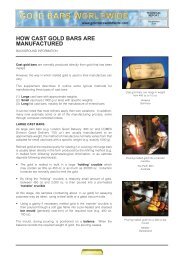Indian Gold Book:Indian Gold Book - Gold Bars Worldwide
Indian Gold Book:Indian Gold Book - Gold Bars Worldwide
Indian Gold Book:Indian Gold Book - Gold Bars Worldwide
Create successful ePaper yourself
Turn your PDF publications into a flip-book with our unique Google optimized e-Paper software.
BANKS<br />
IMPORTED BULLION PRODUCTS<br />
Banks are permitted to import gold bullion cast or minted bars and medallions with a millesimal purity of not<br />
less than 995.<br />
The import of legal tender gold coins is prohibited. Almost all imports for the domestic market are in the form of 10 tola<br />
(TT) bars. Kilobars are also imported, mainly for export jewellery fabricators.<br />
Most imported gold bars are produced by 8 refining companies located in Australia, South Africa, Switzerland and the United<br />
Kingdom.<br />
INTERNATIONAL SUPPLIERS<br />
Banks rely generally on 10 international gold dealers – members of the LBMA – as their suppliers of gold<br />
bullion.<br />
2 of the international dealers supply their bank branches in India directly, notably Bank of Nova Scotia and HSBC. 2 other<br />
suppliers have active liaison offices in India, Mitsui & Co and Societe Generale.<br />
4 of them own, part-own or are directly associated with refiners that manufacture large quantities of TT bars, notably<br />
Commerzbank, Credit Suisse First Boston, MKS Finance and UBS Warburg.<br />
Most banks are obliged to deal with several international dealers due to credit risk constraints. Some are also obliged to<br />
import only TT bars whose refineries are accredited to the LBMA. A minimum order is usually 1,000 – 2,000 TT bars.<br />
DEALING CONSTRAINTS<br />
Due to exchange control regulations, banks are not able to export gold bullion, apart from some leeway<br />
afforded to gold accumulated under the <strong>Gold</strong> Deposit Scheme.<br />
Nor are they able to hedge their bullion imports.<br />
As no bank is prepared to assume the risk of a fluctuating gold price in the absence of a hedging facility, all banks rely on<br />
consignment stocks provided by international dealers. For the same reason, no bank is prepared to buy back bullion from<br />
its customers.<br />
In some States (e.g. Rajasthan), banks without a branch that is registered to receive and pay State sales taxes may not be<br />
permitted to operate in that State.<br />
CONSIGNMENT STOCKS<br />
Most banks rely on consignment stocks located in cities around India.<br />
Some banks will stock 5,000 – 10,000 TT bars or more in different locations. In major import centres, they will often have<br />
consignment stocks from several dealers. As consignment stocks normally incur insurance costs and interest charges if not<br />
sold within 14 days, and the replenishment of stocks can be done within 3 – 5 days, banks monitor their stocks closely.<br />
Consignment stocks, held by the banks combined, can exceed 10 tonnes when high demand is anticipated.<br />
10 banks were active importers in 2001.<br />
AN INTRODUCTION TO THE INDIAN GOLD MARKET 61

















